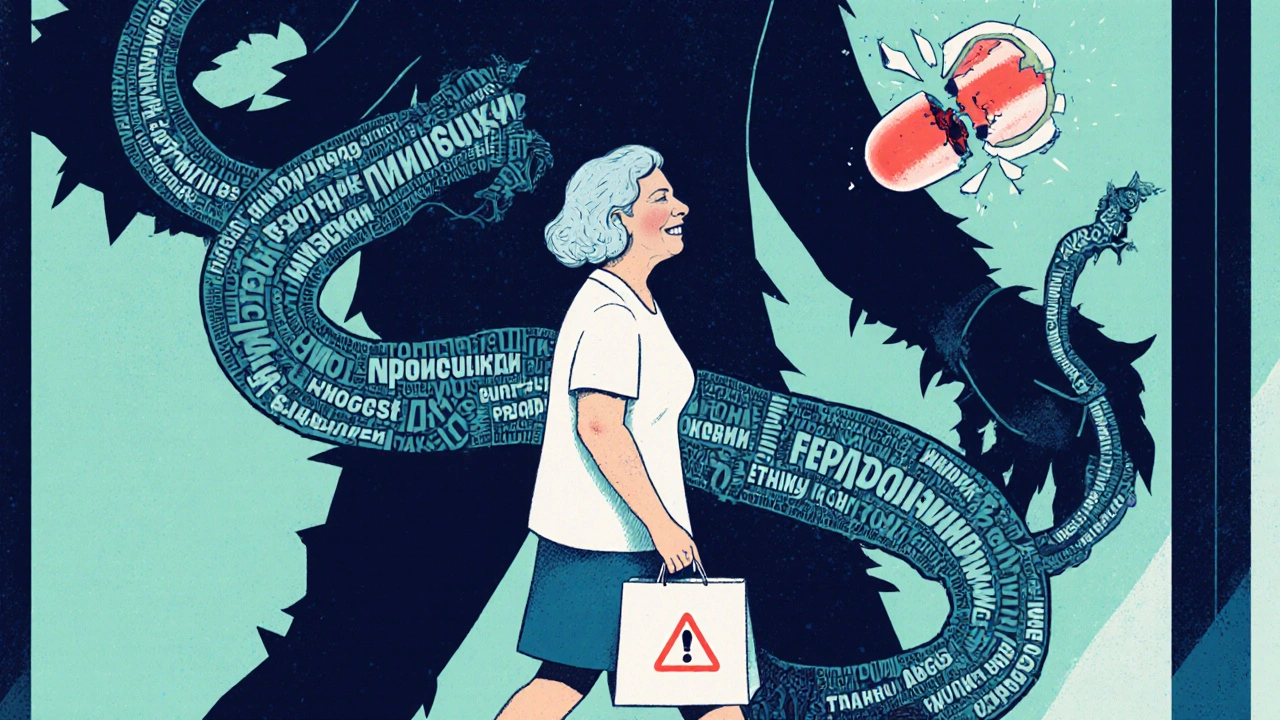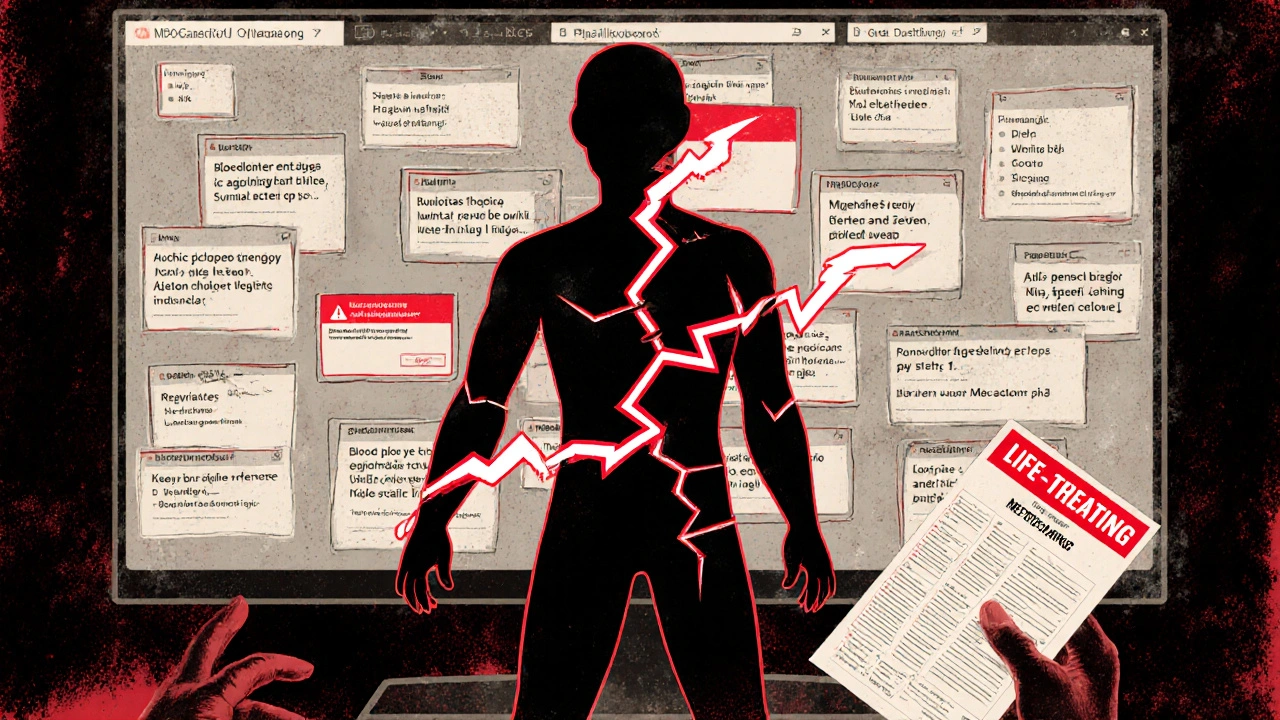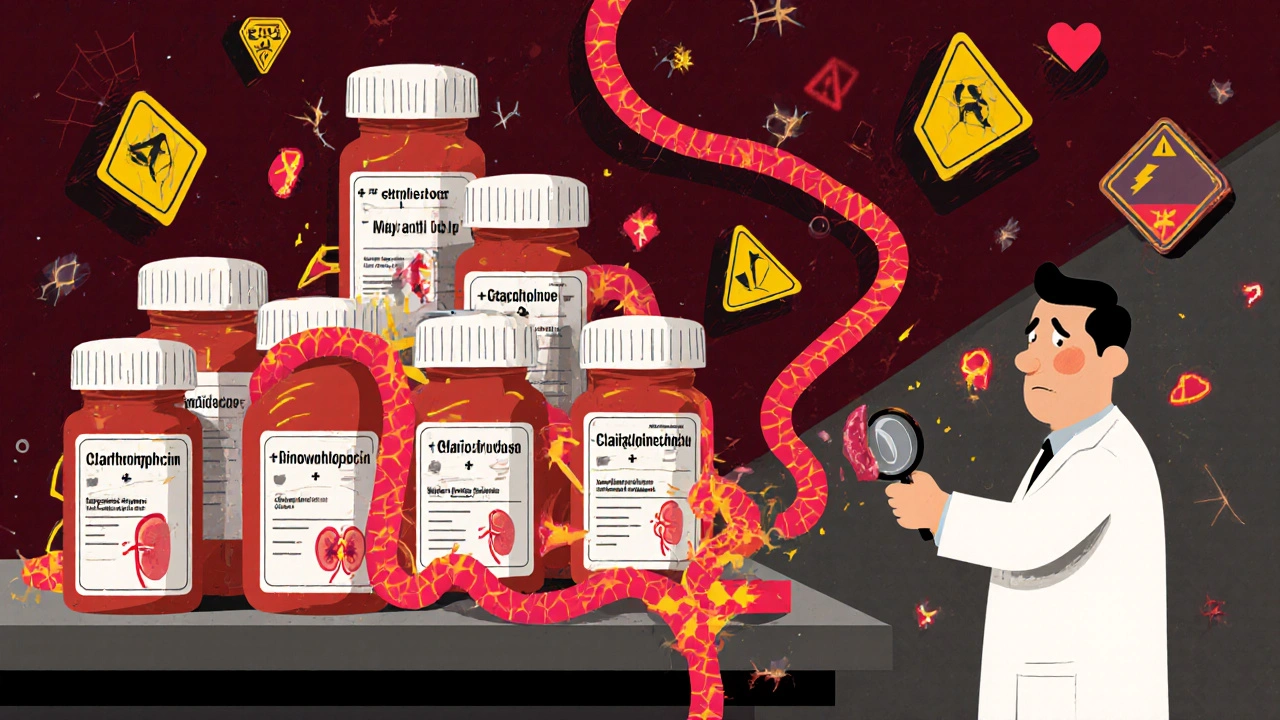Drug Interaction Checker
Check Medication Interactions
Results
Every year, tens of thousands of Americans are hurt or killed by drug combinations that should have been caught before they reached the pharmacy counter. It’s not because pharmacists are careless-it’s because they’re overwhelmed. A 2016 investigation by the Chicago Tribune found that 52% of pharmacies failed to warn patients about life-threatening drug interactions during controlled tests. That means more than half the time, a patient walking out with a new prescription might be walking into danger-and no one caught it.
What Makes a Drug Combination Deadly?
Not all drug interactions are the same. Some cause mild nausea. Others lead to kidney failure, heart block, or sudden death. The real red flags are combinations where two medications, each safe on their own, become dangerous when taken together. These aren’t rare. They’re predictable. And they’re often ignored.One of the most dangerous pairs is simvastatin (a cholesterol drug) and clarithromycin (an antibiotic). Simvastatin is broken down by the liver enzyme CYP3A4. Clarithromycin blocks that enzyme. When that happens, simvastatin builds up in the blood to toxic levels-sometimes raising creatine kinase levels by 10,000 U/L. That’s not just muscle pain. That’s rhabdomyolysis: muscle tissue breaking down, clogging the kidneys, and potentially causing permanent kidney failure or death.
Another deadly combo: colchicine (for gout) and verapamil (a blood pressure drug). Colchicine is already risky at high doses. Verapamil blocks the transporter that clears it from the body. Together, they can cause multi-organ failure. The FDA has issued multiple warnings about this pair, yet pharmacists still miss it.
Then there’s tizanidine (a muscle relaxer) with ciprofloxacin (an antibiotic). Tizanidine can cause extreme drowsiness or even loss of consciousness. Ciprofloxacin slows its breakdown by 500%. One study showed patients on this combo had a 12-fold increase in tizanidine blood levels. That’s not a side effect-it’s a medical emergency waiting to happen.
Birth Control and Antifungals? Yes, That’s a Problem
Some interactions aren’t immediately life-threatening, but they’re just as dangerous in the long run. Take norgestimate/ethinyl estradiol (common birth control pills) and griseofulvin (an antifungal for toenail fungus). Griseofulvin speeds up the liver’s ability to break down estrogen. That means your birth control stops working. Studies show pregnancy rates jump to over 30% when these two are taken together. And if a woman gets pregnant while on griseofulvin, there’s a risk of serious birth defects.Women on birth control are often told to use backup contraception with antibiotics like rifampin-but griseofulvin isn’t even on most people’s radar. Pharmacists don’t always check for it. And patients rarely ask. That’s how someone ends up pregnant, thinking they’re protected.
Warfarin: The Silent Killer
Warfarin (Coumadin) is one of the most common blood thinners in the U.S. It’s also one of the most dangerous when mixed with other drugs. A single wrong combination can turn a routine check-up into a bleeding emergency.Take amiodarone (used for irregular heart rhythms). It blocks the enzymes that clear warfarin from the body. That causes warfarin levels to spike. The result? Uncontrolled bleeding-inside the brain, the gut, even the eyes. The American Academy of Family Physicians says doctors must reduce warfarin doses by 30-50% when starting amiodarone and check INR levels weekly for weeks. But in busy pharmacies, that step gets skipped.
Even some statins are risky with warfarin. Fluvastatin, lovastatin, rosuvastatin, and simvastatin all interfere with warfarin metabolism. Atorvastatin and pravastatin? Much safer. But unless your pharmacist knows this, they won’t suggest a switch.

Why Do Pharmacists Miss These?
It’s not laziness. It’s alert fatigue.Pharmacy computers throw up dozens of warnings for every prescription. Some are for minor issues-like “this drug might cause dizziness.” Others are life-or-death. But the system doesn’t tell the difference. So pharmacists start ignoring them. They learn to click through.
A University of Washington study found that when alert systems were customized to only flag the most dangerous interactions, irrelevant warnings dropped by 78%. Critical interactions caught? Jumped from 48% to 89% in just 18 months. That’s the difference between a system that protects you and one that just makes noise.
But most community pharmacies still use generic alert systems. And with average prescription processing times under 2.5 minutes, pharmacists don’t have time to dig into every warning. They rely on the computer to do it for them.
Who’s Most at Risk?
Older adults are the most vulnerable. On average, people over 65 take 4.5 prescription drugs a day. That’s not just pills for blood pressure and cholesterol-it’s painkillers, sleep aids, antidepressants, heart meds, and more. The more drugs you take, the higher the chance of a bad mix.The FDA says older adults are seven times more likely to be hospitalized from a drug interaction than younger people. And those 65+ account for 35% of all adverse drug events in the U.S.
Pregnant women, children, and people with liver or kidney disease are also at higher risk. But no one is immune. A healthy 40-year-old on a new antibiotic and a common painkiller could still end up in the ER.

What You Can Do
You don’t have to wait for the pharmacist to catch it. You can protect yourself.- Keep a current list of every medication you take-prescription, over-the-counter, vitamins, and supplements. Update it every time something changes.
- Bring that list to every doctor and pharmacist visit. Don’t assume they already know.
- Ask: “Could this new drug interact with anything else I’m taking?” Don’t be shy. This is your life.
- If you’re on warfarin, birth control, or any high-risk drug, ask if your new prescription affects it. If the pharmacist hesitates, ask to speak to the pharmacy manager.
- Use one pharmacy for all your prescriptions. That way, your full med list is in one system. Splitting prescriptions between multiple pharmacies is a recipe for missed interactions.
What’s Being Done?
After the Chicago Tribune report, major chains like CVS and Walgreens updated their protocols. They now require pharmacists to personally verify high-risk combinations before dispensing. Some pharmacies now use tiered alert systems: only the most dangerous interactions trigger mandatory review.The FDA’s 2023-2025 Digital Health Plan is funding AI tools that can predict interactions based on your full medical history-not just drug names. These tools look at your age, kidney function, liver health, and other meds to give smarter warnings.
The CDC recommends mandatory counseling for patients starting high-risk drugs. That could prevent 150,000 adverse events a year. But it’s not mandatory everywhere. And many pharmacies still lack the tech to make it work.
Bottom Line
Drug interactions aren’t accidents. They’re system failures. And they’re preventable. The science is clear. The risks are known. The solutions exist.But they only work if you speak up. If you’re on more than three medications, you’re in the danger zone. Don’t assume your pharmacist caught it. Don’t assume your doctor checked. Ask. Double-check. Push back. Your life might depend on it.
What are the most dangerous drug combinations I should watch out for?
Some of the most dangerous combinations include simvastatin with clarithromycin (risk of muscle breakdown and kidney failure), colchicine with verapamil (toxic buildup leading to organ failure), tizanidine with ciprofloxacin (sudden loss of consciousness), and birth control pills with griseofulvin (contraceptive failure and birth defects). Warfarin with amiodarone or certain statins can cause life-threatening bleeding. Always ask your pharmacist if your new prescription interacts with any of your current meds.
Why don’t pharmacists always catch these dangerous interactions?
Pharmacists face ‘alert fatigue’-their computer systems generate dozens of warnings per prescription, many of which are low-risk. Over time, they start ignoring them. In one study, 52% of pharmacies missed life-threatening interactions during testing. The problem isn’t lack of knowledge-it’s too many false alarms. Pharmacies with customized alert systems that only flag the most dangerous combos have improved detection rates from 48% to 89%.
Are over-the-counter drugs and supplements safe to mix with prescriptions?
No. Many OTC drugs and supplements can cause serious interactions. St. John’s wort can make birth control, antidepressants, and blood thinners ineffective. Garlic, ginkgo, and ginseng can increase bleeding risk with warfarin. Even common pain relievers like ibuprofen can raise blood pressure or damage kidneys when taken with certain heart or kidney meds. Always tell your pharmacist about everything you take-even herbal teas and vitamins.
What should I do if I think my pharmacist missed a dangerous interaction?
Ask to speak to the pharmacy manager immediately. If you’ve already taken the medication, call your doctor or go to urgent care. Don’t wait for symptoms. If you’re on blood thinners, heart meds, or birth control, a missed interaction could be deadly. You have the right to demand a full review of your medication list. If the pharmacy doesn’t take you seriously, consider switching to a different pharmacy that uses a tiered alert system.
Can artificial intelligence help prevent drug interactions in the future?
Yes. The FDA is funding AI tools that analyze your full medical history-not just drug names. These systems consider your age, kidney and liver function, other medications, and even genetic factors to predict real risks. Unlike old systems that flag every possible interaction, AI can prioritize the ones that matter most. Some health systems are already seeing success, with fewer false alarms and more life-saving interventions. But these tools aren’t widespread yet. Until they are, you still need to be your own advocate.
